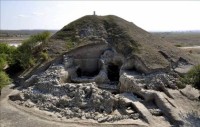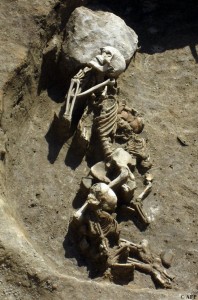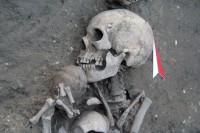 Bulgarian archaeologists are calling the Provadia-Solnitsata site, an ancient salt production center 25 miles inland from the Black Sea resort of Varna, the oldest urban settlement in Europe. It has impressive fortifications, two-story dwellings, ritual sites and intriguing burials with grave goods that provide evidence of class differences, all dating to the middle and late Bronze Age, 4700 to 4200 B.C. The estimated population was between 300 and 350 people. By archaeological standards, a permanent population center with an economic, political and religious function in the region is a city, even when it’s small and remote and far from the highly developed urbs we think of in, say, ancient Greece or Rome.
Bulgarian archaeologists are calling the Provadia-Solnitsata site, an ancient salt production center 25 miles inland from the Black Sea resort of Varna, the oldest urban settlement in Europe. It has impressive fortifications, two-story dwellings, ritual sites and intriguing burials with grave goods that provide evidence of class differences, all dating to the middle and late Bronze Age, 4700 to 4200 B.C. The estimated population was between 300 and 350 people. By archaeological standards, a permanent population center with an economic, political and religious function in the region is a city, even when it’s small and remote and far from the highly developed urbs we think of in, say, ancient Greece or Rome.
I’m reluctant to run the “oldest town in Europe” headline undisputed, however, because there are other candidates (the Serbian site of Vinča outside Belgrade, for instance, which was populated from around 5700 B.C. until the Middle Ages), and none of the articles I’ve read include any detailed arguments in favor of Provadia getting the title. Not that there aren’t reasonable grounds for the claim. The earliest Vinča finds are burials, whereas the Provadia site has developed urban structures as well as burials. There is evidence of salt extraction on the site dating as far back as the Late Neolithic (5500 B.C.) and of a permanent settlement mound from 5200 B.C. to 4900 B.C. There’s a clearly delineated perimeter in the fortification systems, the earliest of which was a wood and earthenwork palisade erected around the settlement mound in the Late Neolithic, followed by masonry construction in two phases during the Chalcolithic period. There are town gates and even a moat. There is evidence of a heterogeneous population in the variety of grave goods. On the other hand, the population was very small. By the demographic definition of a city, 350 people may not quite cross the threshold of population density and social complexity.
What is not in question is that this is a fascinating site, a very early urban settlement with massive walls that grew around a single industry rather than the agriculture and animal husbandry that characterizes other Neolithic and Chalcolithic settlements. The stone walls are an astounding two to three meters (6.5 feet to almost 10 feet) thick in parts, and they even have bastions for added defensive capabilities. Without a doubt, these are the earliest and largest prehistoric European fortifications discovered. The two phases of the stone fortifications could have been the result of earthquake damage requiring reconstruction, or because the settlement was expanding and the walls needed to be pushed out.
 The burials discovered by the excavation team this season are highly unusual. The remains are oddly positioned, and some of them were bisected with only the torsos from the pelvis up being buried. Archaeologists have offered no speculation at this point as to why some of the corpses were buried in their entirety while others were mutilated and buried only in part. The grave goods, ranging from a ceramic bowl to gold jewelry to spiral copper bodkins used to dress women’s hair, testify both to the unprecedented wealth of the settlement and to its social stratification.
The burials discovered by the excavation team this season are highly unusual. The remains are oddly positioned, and some of them were bisected with only the torsos from the pelvis up being buried. Archaeologists have offered no speculation at this point as to why some of the corpses were buried in their entirety while others were mutilated and buried only in part. The grave goods, ranging from a ceramic bowl to gold jewelry to spiral copper bodkins used to dress women’s hair, testify both to the unprecedented wealth of the settlement and to its social stratification.
At the root of this wealth was salt. Once humans began to rely on agriculture and domesticated animals as food sources rather than fish and game, they found they required more salt (there’s a rollicking debate as to whether this was physiological or psychological). Salt supplements aid in dairy production, and salt was a necessity for the preservation of food and the curing of hides. It probably had ritual and medicinal roles as well.
 The rock salt deposits in Provadia-Solnitsata were the only ones in the Balkans, and by the Middle and Late Chalcolithic, they were the primary source of salt for the region. In the late Neolithic, salt was extracted by boiling brine in specially designed ceramic vases and then baking bricks of salt in domed kilns. Initially the kilns were inside the settlement, but were moved outside into shallow sunken cavities around 5000 B.C. It was when the Provadia salt extraction shifted to boiling brine in large ceramic vessels in massive pits that production reached industrial levels.
The rock salt deposits in Provadia-Solnitsata were the only ones in the Balkans, and by the Middle and Late Chalcolithic, they were the primary source of salt for the region. In the late Neolithic, salt was extracted by boiling brine in specially designed ceramic vases and then baking bricks of salt in domed kilns. Initially the kilns were inside the settlement, but were moved outside into shallow sunken cavities around 5000 B.C. It was when the Provadia salt extraction shifted to boiling brine in large ceramic vessels in massive pits that production reached industrial levels.
[Bulgaria’s National Institute of Archeology archaeologist Vasil] Nikolov said production increased steadily from 5,500 BC, when one load from the kilns in Provadia-Solnitsata yielded about 25 kilogrammes (55 pounds) of dry salt. By 4,700-4,500 BC, that amount had increased to 4,000 to 5,000 kilos of salt.
“At a time when salt was as precious as gold you can imagine what this meant,” he said.
It meant Provadia produced enough salt to trade not just locally but to neighboring regions as well, which means big money all the way down the middleman line. Approximately 3,000 pieces of jewelry, ceramics, gold, and other ritual objects have been unearthed at Varna. This is a fantastical amount of wealth, the oldest cache of gold treasure on record, and most probably a result of the early salt trade.
This CNN story has some great shots of the archaeological site, including the bisected burials: